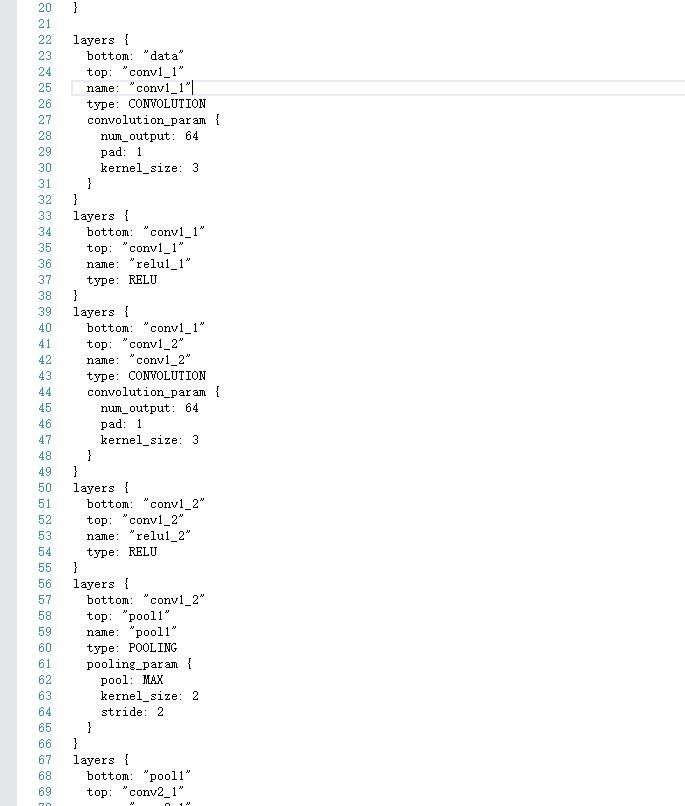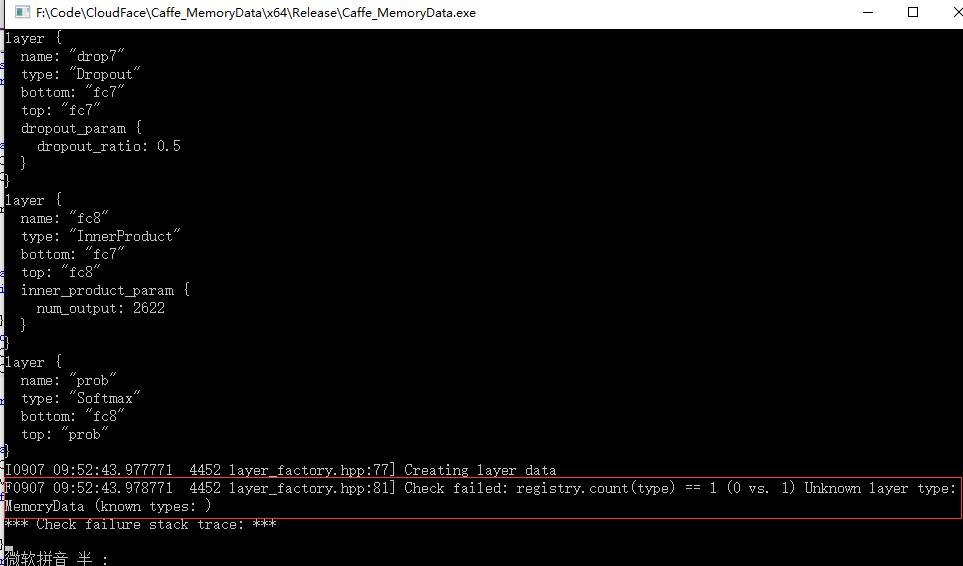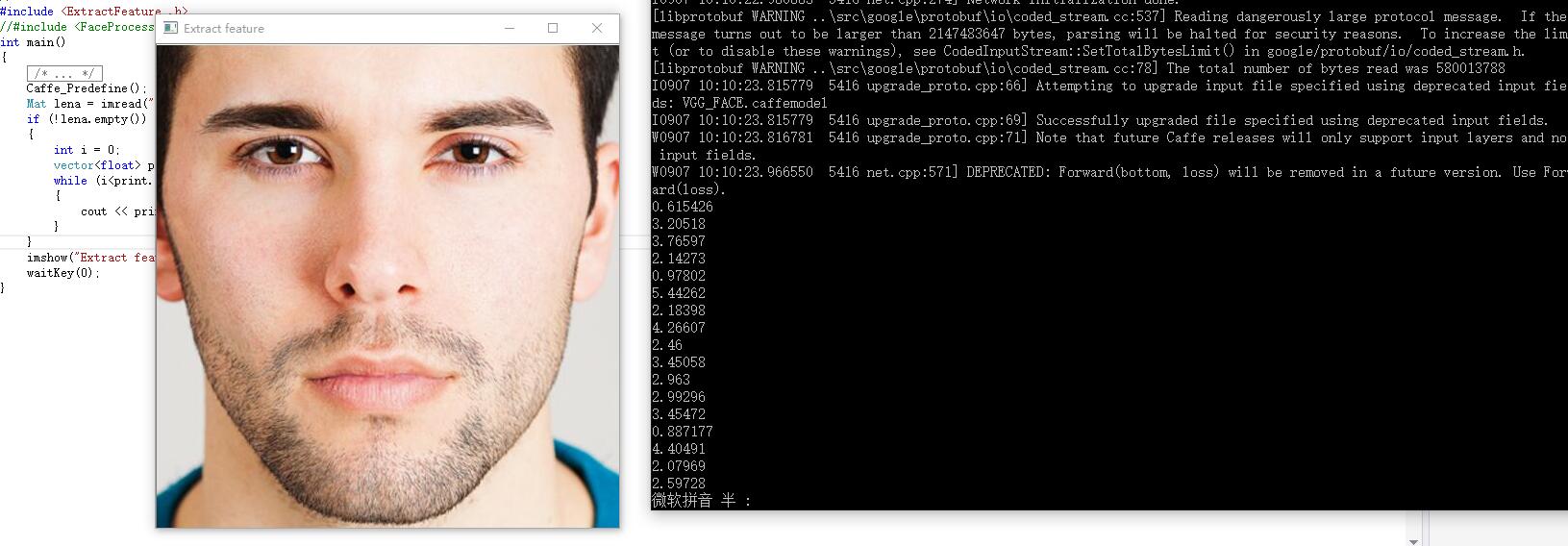原文地址:http://m.blog.csdn.net/article/details?id=52456548
前言
基于深度学习的人脸识别系统,一共用到了5个开源库:OpenCV(计算机视觉库)、Caffe(深度学习库)、Dlib(机器学习库)、libfacedetection(人脸检测库)、cudnn(gpu加速库)。
用到了一个开源的深度学习模型:VGG model。
最终的效果是很赞的,识别一张人脸的速度是0.039秒,而且最重要的是:精度高啊!!!
CPU:intel i5-4590
GPU:GTX 980
系统:Win 10
OpenCV版本:3.1(这个无所谓)
Caffe版本:Microsoft caffe (微软编译的Caffe,安装方便,在这里安利一波)
Dlib版本:19.0(也无所谓
CUDA版本:7.5
cudnn版本:4
libfacedetection:6月份之后的(这个有所谓,6月后出了64位版本的)
这个系列纯C++构成,有问题的各位朋同学可以直接在博客下留言,我们互相交流学习。
====================================================================
本篇是该系列的第三篇博客,介绍如何使用VGG网络模型与Caffe的 MemoryData层去提取一个OpenCV矩阵类型Mat的特征。
思路
VGG网络模型是牛津大学视觉几何组提出的一种深度模型,在LFW数据库上取得了97%的准确率。VGG网络由5个卷积层,两层fc图像特征,一层fc分类特征组成,具体我们可以去读它的prototxt文件。这里是模型与配置文件的下载地址。
http://www.robots.ox.ac.uk/~vgg/software/vgg_face/
话题回到Caffe。在Caffe中提取图片的特征是很容易的,其提供了extract_feature.exe让我们来实现,提取格式为lmdb与leveldb。关于这个的做法,可以看我的这篇博客:
http://blog.csdn.net/mr_curry/article/details/52097529
显然,我们在程序中肯定是希望能够灵活利用的,使用这种方法不太可行。Caffe的Data层提供了type:MemoryData,我们可以使用它来进行Mat类型特征的提取。
注:你需要先按照本系列第一篇博客的方法去配置好Caffe的属性表。
http://blog.csdn.net/mr_curry/article/details/52443126
实现
首先我们打开VGG_FACE_deploy.prototxt,观察VGG的网络结构。

有意思的是,MemoryData层需要图像均值,但是官方网站上并没有给出mean文件。我们可以通过这种方式进行输入:
mean_value:129.1863
mean_value:104.7624
mean_value:93.5940
我们还需要修改它的data层:(你可以用下面这部分的代码去替换下载下来的prototxt文件的data层)
layer {
name: "data"
type: "MemoryData"
top: "data"
top: "label"
transform_param {
mirror: false
crop_size: 224
mean_value:129.1863
mean_value:104.7624
mean_value:93.5940
}
memory_data_param {
batch_size: 1
channels:3
height:224
width:224
}
}
- 1
- 2
- 3
- 4
- 5
- 6
- 7
- 8
- 9
- 10
- 11
- 12
- 13
- 14
- 15
- 16
- 17
- 18
- 19
- 20
为了不破坏原来的文件,把它另存为vgg_extract_feature_memorydata.prototxt。

好的,然后我们开始编写。添加好这个属性表:

然后,新建caffe_net_memorylayer.h、ExtractFeature_.h、ExtractFeature_.cpp开始编写。
caffe_net_memorylayer.h:
#include "caffe/layers/input_layer.hpp"
#include "caffe/layers/inner_product_layer.hpp"
#include "caffe/layers/dropout_layer.hpp"
#include "caffe/layers/conv_layer.hpp"
#include "caffe/layers/relu_layer.hpp"
#include <iostream>
#include "caffe/caffe.hpp"
#include <opencv.hpp>
#include <caffe/layers/memory_data_layer.hpp>
#include "caffe/layers/pooling_layer.hpp"
#include "caffe/layers/lrn_layer.hpp"
#include "caffe/layers/softmax_layer.hpp"
caffe::MemoryDataLayer<float> *memory_layer;
caffe::Net<float>* net;
ExtractFeature_.h
#include <opencv.hpp>
using namespace cv;
using namespace std;
std::vector<float> ExtractFeature(Mat FaceROI);
void Caffe_Predefine();
ExtractFeature_.cpp:
#include <ExtractFeature_.h>
#include <caffe_net_memorylayer.h>
namespace caffe
{
extern INSTANTIATE_CLASS(InputLayer);
extern INSTANTIATE_CLASS(InnerProductLayer);
extern INSTANTIATE_CLASS(DropoutLayer);
extern INSTANTIATE_CLASS(ConvolutionLayer);
REGISTER_LAYER_CLASS(Convolution);
extern INSTANTIATE_CLASS(ReLULayer);
REGISTER_LAYER_CLASS(ReLU);
extern INSTANTIATE_CLASS(PoolingLayer);
REGISTER_LAYER_CLASS(Pooling);
extern INSTANTIATE_CLASS(LRNLayer);
REGISTER_LAYER_CLASS(LRN);
extern INSTANTIATE_CLASS(SoftmaxLayer);
REGISTER_LAYER_CLASS(Softmax);
extern INSTANTIATE_CLASS(MemoryDataLayer);
}
template <typename Dtype>
caffe::Net<Dtype>* Net_Init_Load(std::string param_file, std::string pretrained_param_file, caffe::Phase phase)
{
caffe::Net<Dtype>* net(new caffe::Net<Dtype>("vgg_extract_feature_memorydata.prototxt", caffe::TEST));
net->CopyTrainedLayersFrom("VGG_FACE.caffemodel");
return net;
}
void Caffe_Predefine()
{
caffe::Caffe::set_mode(caffe::Caffe::GPU);
net = Net_Init_Load<float>("vgg_extract_feature_memorydata.prototxt", "VGG_FACE.caffemodel", caffe::TEST);
memory_layer = (caffe::MemoryDataLayer<float> *)net->layers()[0].get();
}
std::vector<float> ExtractFeature(Mat FaceROI)
{
caffe::Caffe::set_mode(caffe::Caffe::GPU);
std::vector<Mat> test;
std::vector<int> testLabel;
std::vector<float> test_vector;
test.push_back(FaceROI);
testLabel.push_back(0);
memory_layer->AddMatVector(test, testLabel);
test.clear(); testLabel.clear();
std::vector<caffe::Blob<float>*> input_vec;
net->Forward(input_vec);
boost::shared_ptr<caffe::Blob<float>> fc8 = net->blob_by_name("fc8");
int test_num = 0;
while (test_num < 2622)
{
test_vector.push_back(fc8->data_at(0, test_num++, 1, 1));
}
return test_vector;
}
- 1
- 2
- 3
- 4
- 5
- 6
- 7
- 8
- 9
- 10
- 11
- 12
- 13
- 14
- 15
- 16
- 17
- 18
- 19
- 20
- 21
- 22
- 23
- 24
- 25
- 26
- 27
- 28
- 29
- 30
- 31
- 32
- 33
- 34
- 35
- 36
- 37
- 38
- 39
- 40
- 41
- 42
- 43
- 44
- 45
- 46
- 47
- 48
- 49
- 50
- 51
- 52
- 53
- 54
=============注意上面这个地方可以这么改:==============
(直接可以知道这个向量的首地址、尾地址,我们直接用其来定义vector)
float* begin = nullptr;
float* end = nullptr;
begin = fc8->mutable_cpu_data();
end = begin + fc8->channels();
CHECK(begin != nullptr);
CHECK(end != nullptr);
std::vector<float> FaceVector{ begin,end };
return std::move(FaceVector);
请特别注意这个地方:
namespace caffe
{
extern INSTANTIATE_CLASS(InputLayer);
extern INSTANTIATE_CLASS(InnerProductLayer);
extern INSTANTIATE_CLASS(DropoutLayer);
extern INSTANTIATE_CLASS(ConvolutionLayer);
REGISTER_LAYER_CLASS(Convolution);
extern INSTANTIATE_CLASS(ReLULayer);
REGISTER_LAYER_CLASS(ReLU);
extern INSTANTIATE_CLASS(PoolingLayer);
REGISTER_LAYER_CLASS(Pooling);
extern INSTANTIATE_CLASS(LRNLayer);
REGISTER_LAYER_CLASS(LRN);
extern INSTANTIATE_CLASS(SoftmaxLayer);
REGISTER_LAYER_CLASS(Softmax);
extern INSTANTIATE_CLASS(MemoryDataLayer);
}
- 1
- 2
- 3
- 4
- 5
- 6
- 7
- 8
- 9
- 10
- 11
- 12
- 13
- 14
- 15
- 16
- 17
为什么要加这些?因为在提取过程中发现,如果不加,会导致有一些层没有注册的情况。我在Github的Microsoft/Caffe上帮一外国哥们解决了这个问题。我把问题展现一下:

如果我们加了上述代码,就相当于注册了这些层,自然就不会有这样的问题。
在提取过程中,我提取的是fc8层的特征,2622维。当然,最后一层都已经是分类特征了,最好还是提取fc7层的4096维特征。
在这个地方:
void Caffe_Predefine()
{
caffe::Caffe::set_mode(caffe::Caffe::GPU);
net = Net_Init_Load<float>("vgg_extract_feature_memorydata.prototxt", "VGG_FACE.caffemodel", caffe::TEST);
memory_layer = (caffe::MemoryDataLayer<float> *)net->layers()[0].get();
}
是一个初始化的函数,用于将VGG网络模型与提取特征的配置文件进行传入,所以很明显地,在提取特征之前,需要先:
Caffe_Predefine();
进行了这个之后,这些全局量我们就能一直用了。
我们可以试试提取特征的这个接口。新建一个main.cpp,调用之:
#include <ExtractFeature_.h>
int main()
{
Caffe_Predefine();
Mat lena = imread("lena.jpg");
if (!lena.empty())
{
ExtractFeature(lena);
}
}
因为我们得到的是一个vector< float>类型,所以我们可以把它逐一输出出来看看。当然,在ExtractFeature()的函数中你就可以这么做了。我们还是在main()函数里这么做。
来看看:
#include <ExtractFeature_.h>
int main()
{
Caffe_Predefine();
Mat lena = imread("lena.jpg");
if (!lena.empty())
{
int i = 0;
vector<float> print=ExtractFeature(lena);
while (i<print.size())
{
cout << print[i++] << endl;
}
}
imshow("Extract feature",lena);
waitKey(0);
}
- 1
- 2
- 3
- 4
- 5
- 6
- 7
- 8
- 9
- 10
- 11
- 12
- 13
- 14
- 15
- 16
- 17
那么对于这张图片,提取出的特征,就是很多的这些数字:

提取一张224*224图片特征的时间为:0.019s。我们可以看到,GPU加速的效果是非常明显的。而且我这块显卡也就是GTX980。不知道泰坦X的提取速度如何(泪)。
附:net结构 (prototxt),注意layer和layers的区别:
name: "VGG_FACE_16_layer"
layer {
name: "data"
type: "MemoryData"
top: "data"
top: "label"
transform_param {
mirror: false
crop_size: 224
mean_value:129.1863
mean_value:104.7624
mean_value:93.5940
}
memory_data_param {
batch_size: 1
channels:3
height:224
width:224
}
}
layer {
bottom: "data"
top: "conv1_1"
name: "conv1_1"
type: "Convolution"
convolution_param {
num_output: 64
pad: 1
kernel_size: 3
}
}
layer {
bottom: "conv1_1"
top: "conv1_1"
name: "relu1_1"
type: "ReLU"
}
layer {
bottom: "conv1_1"
top: "conv1_2"
name: "conv1_2"
type: "Convolution"
convolution_param {
num_output: 64
pad: 1
kernel_size: 3
}
}
layer {
bottom: "conv1_2"
top: "conv1_2"
name: "relu1_2"
type: "ReLU"
}
layer {
bottom: "conv1_2"
top: "pool1"
name: "pool1"
type: "Pooling"
pooling_param {
pool: MAX
kernel_size: 2
stride: 2
}
}
layer {
bottom: "pool1"
top: "conv2_1"
name: "conv2_1"
type: "Convolution"
convolution_param {
num_output: 128
pad: 1
kernel_size: 3
}
}
layer {
bottom: "conv2_1"
top: "conv2_1"
name: "relu2_1"
type: "ReLU"
}
layer {
bottom: "conv2_1"
top: "conv2_2"
name: "conv2_2"
type: "Convolution"
convolution_param {
num_output: 128
pad: 1
kernel_size: 3
}
}
layer {
bottom: "conv2_2"
top: "conv2_2"
name: "relu2_2"
type: "ReLU"
}
layer {
bottom: "conv2_2"
top: "pool2"
name: "pool2"
type: "Pooling"
pooling_param {
pool: MAX
kernel_size: 2
stride: 2
}
}
layer {
bottom: "pool2"
top: "conv3_1"
name: "conv3_1"
type: "Convolution"
convolution_param {
num_output: 256
pad: 1
kernel_size: 3
}
}
layer {
bottom: "conv3_1"
top: "conv3_1"
name: "relu3_1"
type: "ReLU"
}
layer {
bottom: "conv3_1"
top: "conv3_2"
name: "conv3_2"
type: "Convolution"
convolution_param {
num_output: 256
pad: 1
kernel_size: 3
}
}
layer {
bottom: "conv3_2"
top: "conv3_2"
name: "relu3_2"
type: "ReLU"
}
layer {
bottom: "conv3_2"
top: "conv3_3"
name: "conv3_3"
type: "Convolution"
convolution_param {
num_output: 256
pad: 1
kernel_size: 3
}
}
layer {
bottom: "conv3_3"
top: "conv3_3"
name: "relu3_3"
type: "ReLU"
}
layer {
bottom: "conv3_3"
top: "pool3"
name: "pool3"
type: "Pooling"
pooling_param {
pool: MAX
kernel_size: 2
stride: 2
}
}
layer {
bottom: "pool3"
top: "conv4_1"
name: "conv4_1"
type: "Convolution"
convolution_param {
num_output: 512
pad: 1
kernel_size: 3
}
}
layer {
bottom: "conv4_1"
top: "conv4_1"
name: "relu4_1"
type: "ReLU"
}
layer {
bottom: "conv4_1"
top: "conv4_2"
name: "conv4_2"
type: "Convolution"
convolution_param {
num_output: 512
pad: 1
kernel_size: 3
}
}
layer {
bottom: "conv4_2"
top: "conv4_2"
name: "relu4_2"
type: "ReLU"
}
layer {
bottom: "conv4_2"
top: "conv4_3"
name: "conv4_3"
type: "Convolution"
convolution_param {
num_output: 512
pad: 1
kernel_size: 3
}
}
layer {
bottom: "conv4_3"
top: "conv4_3"
name: "relu4_3"
type: "ReLU"
}
layer {
bottom: "conv4_3"
top: "pool4"
name: "pool4"
type: "Pooling"
pooling_param {
pool: MAX
kernel_size: 2
stride: 2
}
}
layer {
bottom: "pool4"
top: "conv5_1"
name: "conv5_1"
type: "Convolution"
convolution_param {
num_output: 512
pad: 1
kernel_size: 3
}
}
layer {
bottom: "conv5_1"
top: "conv5_1"
name: "relu5_1"
type: "ReLU"
}
layer {
bottom: "conv5_1"
top: "conv5_2"
name: "conv5_2"
type: "Convolution"
convolution_param {
num_output: 512
pad: 1
kernel_size: 3
}
}
layer {
bottom: "conv5_2"
top: "conv5_2"
name: "relu5_2"
type: "ReLU"
}
layer {
bottom: "conv5_2"
top: "conv5_3"
name: "conv5_3"
type: "Convolution"
convolution_param {
num_output: 512
pad: 1
kernel_size: 3
}
}
layer {
bottom: "conv5_3"
top: "conv5_3"
name: "relu5_3"
type: "ReLU"
}
layer {
bottom: "conv5_3"
top: "pool5"
name: "pool5"
type: "Pooling"
pooling_param {
pool: MAX
kernel_size: 2
stride: 2
}
}
layer {
bottom: "pool5"
top: "fc6"
name: "fc6"
type: "InnerProduct"
inner_product_param {
num_output: 4096
}
}
layer {
bottom: "fc6"
top: "fc6"
name: "relu6"
type: "ReLU"
}
layer {
bottom: "fc6"
top: "fc6"
name: "drop6"
type: "Dropout"
dropout_param {
dropout_ratio: 0.5
}
}
layer {
bottom: "fc6"
top: "fc7"
name: "fc7"
type: "InnerProduct"
inner_product_param {
num_output: 4096
}
}
layer {
bottom: "fc7"
top: "fc7"
name: "relu7"
type: "ReLU"
}
layer {
bottom: "fc7"
top: "fc7"
name: "drop7"
type: "Dropout"
dropout_param {
dropout_ratio: 0.5
}
}
layer {
bottom: "fc7"
top: "fc8"
name: "fc8"
type: "InnerProduct"
inner_product_param {
num_output: 2622
}
}
layer {
bottom: "fc8"
top: "prob"
name: "prob"
type: "Softmax"
}
- 1
- 2
- 3
- 4
- 5
- 6
- 7
- 8
- 9
- 10
- 11
- 12
- 13
- 14
- 15
- 16
- 17
- 18
- 19
- 20
- 21
- 22
- 23
- 24
- 25
- 26
- 27
- 28
- 29
- 30
- 31
- 32
- 33
- 34
- 35
- 36
- 37
- 38
- 39
- 40
- 41
- 42
- 43
- 44
- 45
- 46
- 47
- 48
- 49
- 50
- 51
- 52
- 53
- 54
- 55
- 56
- 57
- 58
- 59
- 60
- 61
- 62
- 63
- 64
- 65
- 66
- 67
- 68
- 69
- 70
- 71
- 72
- 73
- 74
- 75
- 76
- 77
- 78
- 79
- 80
- 81
- 82
- 83
- 84
- 85
- 86
- 87
- 88
- 89
- 90
- 91
- 92
- 93
- 94
- 95
- 96
- 97
- 98
- 99
- 100
- 101
- 102
- 103
- 104
- 105
- 106
- 107
- 108
- 109
- 110
- 111
- 112
- 113
- 114
- 115
- 116
- 117
- 118
- 119
- 120
- 121
- 122
- 123
- 124
- 125
- 126
- 127
- 128
- 129
- 130
- 131
- 132
- 133
- 134
- 135
- 136
- 137
- 138
- 139
- 140
- 141
- 142
- 143
- 144
- 145
- 146
- 147
- 148
- 149
- 150
- 151
- 152
- 153
- 154
- 155
- 156
- 157
- 158
- 159
- 160
- 161
- 162
- 163
- 164
- 165
- 166
- 167
- 168
- 169
- 170
- 171
- 172
- 173
- 174
- 175
- 176
- 177
- 178
- 179
- 180
- 181
- 182
- 183
- 184
- 185
- 186
- 187
- 188
- 189
- 190
- 191
- 192
- 193
- 194
- 195
- 196
- 197
- 198
- 199
- 200
- 201
- 202
- 203
- 204
- 205
- 206
- 207
- 208
- 209
- 210
- 211
- 212
- 213
- 214
- 215
- 216
- 217
- 218
- 219
- 220
- 221
- 222
- 223
- 224
- 225
- 226
- 227
- 228
- 229
- 230
- 231
- 232
- 233
- 234
- 235
- 236
- 237
- 238
- 239
- 240
- 241
- 242
- 243
- 244
- 245
- 246
- 247
- 248
- 249
- 250
- 251
- 252
- 253
- 254
- 255
- 256
- 257
- 258
- 259
- 260
- 261
- 262
- 263
- 264
- 265
- 266
- 267
- 268
- 269
- 270
- 271
- 272
- 273
- 274
- 275
- 276
- 277
- 278
- 279
- 280
- 281
- 282
- 283
- 284
- 285
- 286
- 287
- 288
- 289
- 290
- 291
- 292
- 293
- 294
- 295
- 296
- 297
- 298
- 299
- 300
- 301
- 302
- 303
- 304
- 305
- 306
- 307
- 308
- 309
- 310
- 311
- 312
- 313
- 314
- 315
- 316
- 317
- 318
- 319
- 320
- 321
- 322
- 323
- 324
- 325
- 326
- 327
- 328
- 329
- 330
- 331
- 332
- 333
- 334
- 335
- 336
- 337
- 338
- 339
- 340
- 341
- 342
- 343
- 344
- 345
- 346
- 347
- 348
- 349
- 350
- 351
- 352
- 353
- 354
- 355
- 356
- 357
- 358
- 359
- 360
=================================================================



























 2483
2483

 被折叠的 条评论
为什么被折叠?
被折叠的 条评论
为什么被折叠?








